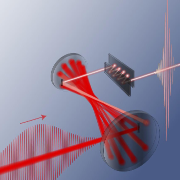New possibilities for ultra-fast physics and plasma acceleration
With the help of a special “light compressor”, a team of researchers has produced ultrashort laser pulses at DESY. In collaboration with colleagues from Sweden and France, scientists led by Christoph Heyl from DESY and the Helmholtz Institute Jena succeeded in compressing high-energy laser pulses of about one third of a millimetre in length to under a hundredth of a millimetre in just one step. “This corresponds to a factor of almost 40, a new record for a single compression stage for high-energy laser pulses,” says Heyl. Around 80 percent of the energy of the original laser pulse was retained. In a further step, the researchers compressed the pulses to only about 4 thousandths of a millimeter (micrometre), which is about one tenth of the thickness of a human hair. The team presents its work in the journal Optics Letters.
Ultra-short laser pulses are needed in many areas of research, including ultrafast dynamics of matter and plasma acceleration. The former will help to expand the capabilities of X-ray lasers like DESY’s FLASH and the European XFEL, the latter is the basis for a new generation of compact particle accelerators. For these plasma wakefield accelerators, a strong laser pulse in a gas is used to generate a plasma wave on which electrically charged particles like electrons can be rapidly accelerated. “Ultra-short pulse femtosecond lasers have so far only been available with an average power of a few watts,” explains Heyl. “Picosecond lasers, on the other hand, can nowadays easily generate several kilowatts of average power without problems.” The average power determines how many times a laser can flash per second. “Only laser systems with a high pulse repetition rate can meet the requirements of modern acceleration systems,” says Heyl.

この情報へのアクセスはメンバーに限定されています。ログインしてください。メンバー登録は下記リンクをクリックしてください。

